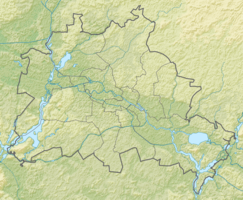Great Fenn (Berlin)
|
Big Fenn
|
||
| location | Wannsee , Germany | |
| surface | 6.39 ha | |
| Identifier | NSG-06 | |
| WDPA ID | 81772 | |
| Geographical location | 52 ° 24 ' N , 13 ° 9' E | |
|
|
||
| Setup date | 5th December 1986 | |
The Großer Fenn is a moorland and nature reserve in the Berlin district of Wannsee in the Steglitz-Zehlendorf district . It is in the hunt 60 of the Düppel forest .
Protected position
Großes Fenn was declared a nature reserve in accordance with Sections 18 and 19 of the Berlin Nature Conservation Act in the version of January 30, 1979 (GVBl. P. 183), amended by the law of October 3, 1983 (GVBl. P. 1290). The Protected Areas Ordinance came into force on December 5, 1986.
description
The Great Fenn is 6.39 hectares in size, of which the Kesselmoor area is 1.9 hectares. It arose from a silted up dead ice hole at the end of the last ice age . The topsoil of the Großer Fenn shows an 8 or 17 cm thick layer of sand that covered the radicell peat containing peat moss. In the sunken center, the bog water levels were close below the corridor. In addition, flat peat shrinkage horizons can be seen down to a depth of 40 centimeters. The moor area is only 1 to 2 meters above the level of the Havel lowlands (31–32 meters above sea level ). Because the area is tall with pine trees , the water supply cannot be controlled according to the current state of knowledge, since there is no drinking water supply and measures cannot currently be taken. There would be the possibility of rewetting , but then the topsoil would have to be removed in the moor center.
Flora and fauna
The area is considered to be a severely disturbed peat moss-cottongrass intermediate moor with pipe grass and swamp riding grass stands . Typical types of intermoor and the cranberry are seldom found , but in the 1990s the round-leaved and medium-sized sundew or the narrow-leaved and scabbard cottongrass were detected, these are no longer seen today. The fen species as well as the swamp violet , pennywort , ostrich-flowered loosestrife , swamp blood-eye , stiff sedge and gray sedge are also rarely found ; all of these plants are on the Berlin Red List. Peat moss can be seen frequently or in places . The drying up of the bog is one reason that pine trees grow in the bog depression. Rare invertebrate species have been identified in the Great Fenn, as well as the canopy spider .
Protection purpose and care
The area has been severely impaired in the past few decades by the drying up with the accompanying pine vegetation. Its evaporation increases the water deficit. This also has consequences for the increasing mineralization of the soil. Because the peat loses its water-containing effect, it can be broken down. In 1997 there was a fire and it displaced the bog vegetation. The water balance in this area is very disturbed. These causes have not yet been clarified and can hardly or not at all be improved by care measures. However, trees that have grown sporadically are removed.
literature
- Roland Lehmann: Of course Berlin !: Nature conservation and NATURA 2000 areas in Berlin . 2nd Edition. Verl. Natur und Text, Rangsdorf 2009, ISBN 978-3-9810058-9-9 , p. 196-197 .
Web links
Individual evidence
- ^ A b Ordinance on the Großes Fenn nature reserve in the Zehlendorf district of Berlin, Wannsee district , PDF; 28 kB
- ↑ Humboldt University, Department of Soil Science: Large Fenn and Small Fenn in the Berlin Forest Düppel | Berlin peat soils in climate change. Retrieved October 17, 2018 .


